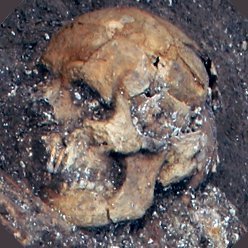
Ancestral Whispers
@Sulkalmakh
Followers
22K
Following
592
Media
638
Statuses
1K
Facial reconstructions, Anthropology, Archaeogenetics, Archaeology, Ethnography.
Joined March 2020
Facial and hypothetical artistic reconstruction commissions are open. Visit https://t.co/uDD5iJBVup to get a glimpse of our work and services. To delve deeper into the methodology behind our reconstructions, visit https://t.co/xEWZxj6zRi
9
20
154
Facial reconstruction of a 5,400-year-old man from Kazakhstan The people of the Eneolithic Botai culture were about 80% ANE, with the remainder being East Eurasian and a small amount of WHG ancestry introduced through EHG gene flow. Populations today with high ANE ancestry
16
17
140
Sites with Cremation in the Caucasus in the Late Bronze/Early Iron Age
1
7
71
Facial reconstructions of the Hasanlu Lovers The people of Iron Age Hasanlu were genetically a mixture of Zagrosians, Upper Mesopotamians, and Proto-Armenics. Hasanlu is an archaeological site of an ancient city located in northwest Iran, in the province of West Azerbaijan,
31
46
317
Facial reconstruction of a 2,800-year-old man from Armenia According to Assyrian sources from the 9th–8th centuries BC, the state of Urartu gradually formed on the Armenian Highlands. Early texts mention the “lands of Uruatri,” a tribal confederation resisting Assyrian expansion
13
19
171
Facial reconstruction of a 3,200-year-old man from Cis-Baikal The Glazkov culture was a Baikal region culture that existed between 2200 and 1200 BC. It belonged to the Cisbaikal_LNBA cluster associated with Proto-Yeniseian peoples. It also represents one of the Siberian
11
20
121
Reconfiguration of the outdated East–West classification of Iranian languages based on core systematic sound correspondences and shared innovations in morphology and phonology, drawing primarily on the works of linguists such as Agnes Korn, Ľubomír Novák, and others.
17
14
101
Pic 1. Reconstruction of a fully armed Koban warrior based on archaeological findings. Pic 2. Kobanian belt. Such belts were characteristic of the Caucasus from the Bronze Age to Antiquity. On one of the belts found in Tli, archaeologists believe the depictions represent
1
5
58
Facial reconstruction of a 3,000-year-old man from Ossetia The Koban culture emerged by the end of the Bronze Age, during a period of major Kartvelian expansion throughout the Caucasus. At this time, the Kartvelians experienced significant population growth and technological
10
23
146
Facial reconstruction of a 25,000-year-old Gravettian The man, whose remains were found in France, comes from one of the more famous Upper Paleolithic sites, Grotte des Enfants. This site yielded several human remains, among which were two children known in anthropological
14
14
115
Facial reconstruction of a 12,580-year-old American woman. Her remains were found in a quarry near Buhl, Idaho, United States, in January 1989. The Buhl skull exhibited a suite of craniofacial features that fall within the range of Native American or East Asian populations.
10
18
149
Pigmentation of Tarim_EMBA individuals: the first image is based on the physical remains (mummies), while the other two are inferred from genetic data.
3
2
29
Facial Reconstruction of a 4,000-year-old man from Xinjiang, belonging to the Gumugou culture. The Early Middle Bronze Age people of the Tarim Basin were about 80% Ancient North Eurasian, with the rest being East Eurasian. Populations today with high ANE ancestry include West
7
18
169
Facial reconstruction of a 3600-year-old man from Vietnam. He was recovered from the Man Bac site in Ninh Binh Province, northern Vietnam. The cranial series from Neolithic Man Bac generally cluster with early Metal Age Vietnamese (such as Dong Son) and with Neolithic to early
9
11
89



